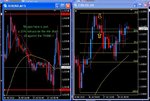ChattiFX
Member
- Messages
- 66
- Likes
- 4
Not sure that is the best title but I can't think of a better one... :-/
As part of my trading strategy I first define a general/overall direction to the pair. i.e. is it Bullish or Bearish. The way I do this is to use a Triangular Moving Average on a time-scale longer than the time-scale I get my signals from. So my strategy takes signals from a 5 minute chart but I use a TMA on a 4 hour chart to give me the general direction on whether to open on long signals or short signals.
Recently I have been looking at this and asking myself the question why I do this. Obviously there are times when the price is moving against the TMA trend or crossing back and forth... and of course these are the times I am losing money.
Just plotting a TMA60 on the 4hr of EUR/USD you can see that the last month and a bit this would have been fairly accurate but through Mar/Apr/May it would have been not so good as there were a number of false crossings and sideways movement...
Now this problem with MA's is nothing new I realise and this isn't meant to be a "please tell me the holy grail of trend indicators..."!!
What I am interested in is if people always filter to only trade long/short, whether through technical or fundamental analysis?
I will be running a test in the next week or so to see if applying my TMA does actually make a difference. I will be running my normal strategy alongside a demo account running exactly the same signals but no TMA filter to give direction, and I'll post some results once I have them.
I also adapt the value of the TMA manually to "best-fit" using S/R. Whilst this is lagging and obviously wouldn't make any sense for signals I think it helps for general direction but I'm going to do a bit of research on adaptive MA's as they are not something I've ever looked in to before and maybe they would offer something.
Anyway, like I said, I'm really interested in peoples views on how and if they take "bigger picture" view of the trend, and the type of method they use. No specifics just TA or FA, maybe which indicators you use etc... no need to give settings, I'm just interested in how people approach this very broad subject.
Cheers,
CFX
As part of my trading strategy I first define a general/overall direction to the pair. i.e. is it Bullish or Bearish. The way I do this is to use a Triangular Moving Average on a time-scale longer than the time-scale I get my signals from. So my strategy takes signals from a 5 minute chart but I use a TMA on a 4 hour chart to give me the general direction on whether to open on long signals or short signals.
Recently I have been looking at this and asking myself the question why I do this. Obviously there are times when the price is moving against the TMA trend or crossing back and forth... and of course these are the times I am losing money.
Just plotting a TMA60 on the 4hr of EUR/USD you can see that the last month and a bit this would have been fairly accurate but through Mar/Apr/May it would have been not so good as there were a number of false crossings and sideways movement...
Now this problem with MA's is nothing new I realise and this isn't meant to be a "please tell me the holy grail of trend indicators..."!!
What I am interested in is if people always filter to only trade long/short, whether through technical or fundamental analysis?
I will be running a test in the next week or so to see if applying my TMA does actually make a difference. I will be running my normal strategy alongside a demo account running exactly the same signals but no TMA filter to give direction, and I'll post some results once I have them.
I also adapt the value of the TMA manually to "best-fit" using S/R. Whilst this is lagging and obviously wouldn't make any sense for signals I think it helps for general direction but I'm going to do a bit of research on adaptive MA's as they are not something I've ever looked in to before and maybe they would offer something.
Anyway, like I said, I'm really interested in peoples views on how and if they take "bigger picture" view of the trend, and the type of method they use. No specifics just TA or FA, maybe which indicators you use etc... no need to give settings, I'm just interested in how people approach this very broad subject.
Cheers,
CFX

